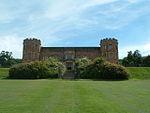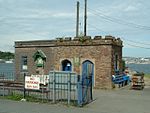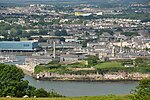Picklecombe Fort
Forts in CornwallForts of Plymouth, DevonGrade II listed buildings in CornwallGrade II listed fortsMilitary history of Cornwall ... and 1 more
Palmerston Forts

Fort Picklecombe stands on the extreme south eastern coast of Cornwall, a couple of miles west of the city of Plymouth. The fort has been a residential complex since the early 1970s but has a history dating back 150 years.
Excerpt from the Wikipedia article Picklecombe Fort (License: CC BY-SA 3.0, Authors, Images).Picklecombe Fort
B3247,
Geographical coordinates (GPS) Address Nearby Places Show on map
Geographical coordinates (GPS)
| Latitude | Longitude |
|---|---|
| N 50.343611111111 ° | E -4.1722222222222 ° |
Address
B3247
PL10 1HR , Maker-with-Rame
England, United Kingdom
Open on Google Maps










